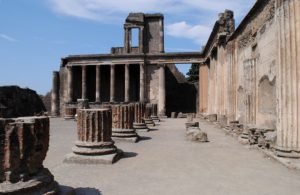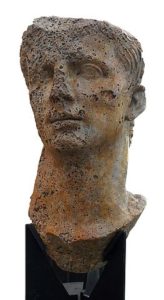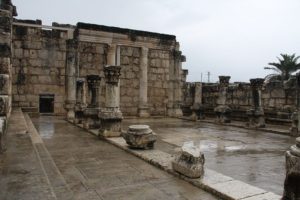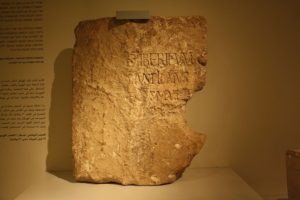Last week we looked at evidence for the reliability of the Old Testament through archeological discoveries. To date there have been over 25,000 finds that support the Biblical record, and no valid archeological find has ever disproven a Biblical account. Archeology is important in Biblical studies because it uncovers physical evidence from dig sites that help confirm ancient cities, fortresses, and artifacts like coinage, pottery and sculptures that directly or indirectly give support to both Old and New Testament accounts along with an understanding of the culture at the time.
The exciting part of archeology is that so much of what is uncovered from the first century, where Jesus walked and taught, is being preserved for us to see today! In many cases new cities were built right on top of the previous ones that had been conquered or destroyed. Archeologists can go in and uncover, in a painstakingly slow process, the ruins of these early cultures and this is what tourists get to see today in places like Jerusalem, Rome, and many other modern day locations. We can trace Jesus’ footsteps on the “Via Dolorosa” or walk where Paul did on “Straight Street” in Damascus.
This what we find in the Bible: Real people in real places, anchored in real events that have real history, not mythology.
“As a matter of fact, however, it may be stated categorically that no archaeological discovery has ever controverted a biblical reference. Scores of archaeological findings have been made which confirm in clear outline or exact detail historical statements in the Bible”
– Nelson Glueck, Archeologist, “Rivers in the Desert”
Even secular news has reported:
“In extraordinary ways, modern archaeology has affirmed the historical core of the Old and New Testaments—corroborating key portions of the stories of Israel’s patriarchs, the Exodus, the Davidic monarchy, and the life and times of Jesus.”
– Jeffery Sheler, “Is the Bible True,” US News & World Report
Checkout this short clip on how archeology helps confirm the New Testament:
Eight ‘Exciting’ New Testament Examples:
So many of the people and places that were recorded in the New Testament are grounded in coinage, monuments, and places you can still see today, for example:
- Inscription of Caesar Augustus on coinage dated from that era: Emperor when Jesus was born
- Coinage is one of the most unbiased pieces of evidence—it dates eras of time and has always help support Biblical accounts like the one in Matthew 22:15-22 where Jesus had a confrontation with Pharisees
- This particular find confirms Luke’s Gospel account in chapter two, that Caesar Augustus was Emperor at that time
- Synagogue at Capernaum: A place where Jesus taught
- You can see the layer of the first century ruin still there today with subsequent building on top of it
- Confirms Luke’s Gospel account in chapter seven
- Monument of Herod the Great in Jerusalem: King when Jesus was born
- Monuments, like coinage, give us undeniable evidence of specific people and the time they existed in real history—this Herod began his rule in 37 BC/BCE
- Confirms Matthew’s Gospel account in chapter two
- Jordon River: The place of Jesus’ Baptism
- Rivers, like lakes and seas, give us geographical evidence of event locations and this river is still there today
- Confirms Matthew’s Gospel account in chapter three
- The Sea of Galilee: Where Jesus walked, went fishing, and talked to the people
- This sea, like many others, are still there today and give evidence of real historical settings in the Biblical accounts
- Confirms the Gospel accounts of the location of Jesus’ ministry
Significant finds in archeology have continued to support the Biblical accounts in the New Testament, especially those that were in doubt for centuries, for example:
- John’s account in Chapter five of his Gospel was thought, by skeptics, to be fictional because there had been no porches or pools found in that area of Jerusalem.
- At the turn of the twentieth century all five porches and the two pools were excavated about 300 feet north of the Temple Mount’s northern wall.
- Confirms the pool of Bethesda exists and the continued historical accuracy of the Gospel of John.
- Pilate and Caiaphas were thought, by skeptics, to be mythological characters because there were no records of them outside the New Testament.
- In 1961 an Italian archeology group uncovered a stone in the Jerusalem area that said: “Pontius Pilate, Perfect of Judea, has presented this Tiberium to the Caesarians.”
- And, in 1990 an ossuary (bone box) with the name Joseph Caiaphas was found dated to the first century.
- Confirms the historical existence of Pilate and Caiaphas and the continued accuracy of the Gospel records.
- Skeptics also claimed that crucifixion was not used in the first century since there have been no physical specimens of a person who had been crucified.
- In 1968 archeologists found a fossil of a crucifixion nail in an ankle bone at a Jerusalem location that dates to the first century and the time of Christ: Yohanan—a crucifixion victim from c. A.D. 70. Crucifixion has also been confirmed through various historical writings outside the Bible as a method of torture and death by Rome only in this time period.
- Confirms the historical accuracy of the use of crucifixion, and nails, in the first century.
Going Deeper:
Watch this video for more on the archeological evidence of the New Testament:
The God who made the world and all things in it, since He is Lord of heaven and earth, does not dwell in temples made with hands’ nor is He served by human hands, as though He needed anything, since He Himself gives to all people life and breath and all things; and He made from one man every nation of mankind to live on all the face of the earth, having determined their appointed times and the boundaries of their habitation, that they would seek God, if perhaps they might grope for Him and find Him, though He is not far from each one of us; for in Him we live and move and exist. -Acts 17:24-28
Two excellent book sources:
The Popular Handbook of Archeology and the Bible, Discoveries that Confirm the Reliability of Scripture, by Joseph M. Holden and Norman Geisler
Bible Archeology, An Exploration of the History and Culture of Early Civilizations, by Alfred Hoerth and John McRay
Reflection:
- Pick one or two of the New Testament archeological finds and write it down, then commit it to memory and share with someone.
- Prayer focus—A chance to share some things about the Bible with someone whom you cross paths.
———————————————————————————————————
You will not find this material in the public school curriculum even though it is based on solid evidence and grounded in research. It is ironic that following the evidence to where it leads stops at the door of our public schools as they will not let a “Divine footprint” in! Join us as we examine evidence for Christianity and learn how to become a thoughtful defender and ambassador of your faith.
Click into the resource page of this website to view many of the top Christian thinkers and apologists along with some of their work; connecting to these types of resources is essential in your Christian growth.
Please let me know what you think: Give feedback, ask questions or send concerns in the comment section of the blog.
Teri Dugan
TeriDugan@truthfaithandreason.com
1 Peter 3:15








Sorry, comments are closed for this post.